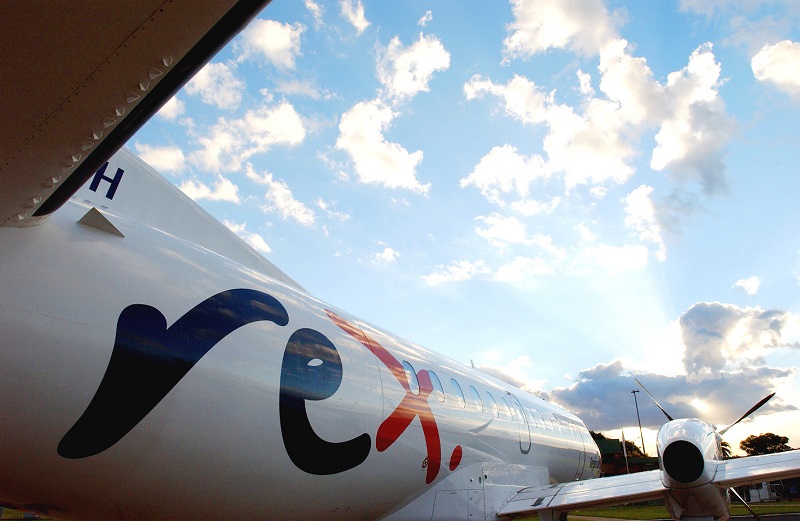Be prepared has been a Scout slogan for more than a century but it’s advice that rookie pilots can sometimes overlook.
Veteran Rex training and check captain Lisa Westcott is the airline’s Saab 340 Flight Standards Manager and there are subjects she advises trainees to master before they even set foot in a cockpit.
There are some aspects that can only be taught in an aircraft or a classroom, but Westcott says there is plenty that can be self-taught.
‘For example, your radio calls can be perfect before you even set foot in a Saab,’ she says.
‘And that will make all your subsequent training so much easier because you don’t have to think about those things.
‘You unload your brain to concentrate on those things you need to learn.
‘If there are things that are second nature to you, they don’t take up the bandwidth you need to manage whatever you have on your plate at that moment.’
As Australia’s largest independent regional and domestic airline, Rex operates a fleet of 60 Saab 340 and 6 Boeing 737-800 NG aircraft to 62 destinations throughout all states in Australia. In addition to the airline Rex, the Rex Group comprises wholly owned subsidiaries Pel-Air Aviation (air freight, aeromedical and charter operator) and two Australian Airline Pilot Academy campuses in Wagga Wagga and Ballarat.
Westcott, who has been flying Saabs for 17 years and is currently based in Cairns, is a fan of the turboprop as a regional aircraft. The type was, she observes, well ahead of its time when it was released.
‘The Saab 340 is a very well-equipped aircraft for regional flying,’’ she says.
Flying to remote and regional communities with non-towered aerodromes has made Westcott a keen supporter of the adage ‘pre-planning prevents poor performance’.
‘Whatever you can do before you get into the situation is always better than chasing your tail and being reactive,’ she says. ‘Whatever you can anticipate, whatever you can prevent occurring, that is always the best way to go.’
Situational awareness and communication are also keys when flying into uncontrolled aerodromes with mixed traffic. Westcott says airline pilots need to be aware that their private counterparts often don’t appreciate the speed at which an aircraft such as a Saab is approaching.
This makes it important to have an appreciation of where private pilots are, what kind of aircraft they are operating and to communicate in terms they understand. ‘They’re possibly flying around in bumpy conditions as a single pilot, no auto-pilot and their hands full,’ she says.
‘If you want them to give you the information that you need, you need to make your information meaningful or it’s going to be useless. We reference everything with IFR distances and IFR waypoints. That’s fine a lot of the time but there are times when it’s not appropriate.’
One aspect of interacting with private aircraft Westcott finds challenging involves general aviation pilots listening to a call but failing to make further broadcasts after deciding the airliner is not a problem for them. ‘That can be an issue sometimes because they don’t really understand what we’re doing, how fast we’re approaching and where we’re going to end up,’ she says, noting that this can be a problem if the other aircraft fails to provide sufficient separation.
Weather can be another bane of regional flying but the Rex flight standards manager says the Saabs are well equipped to handle it. This is reinforced by company procedures, she adds.
Avoiding the worst weather is still the best idea and Westcott looks at the bigger picture of where systems are moving across the region or state as well as what’s happening at airports.
‘It’s really important,’ she says. ‘In Queensland particularly, you get a lot of aerodromes that don’t have an AWIS or even an aerodrome forecast.
‘We’re operating into airports without forecasts and the weather of the general region is more important than ever. You need a really good appreciation of what’s going to happen.’
When it comes to what Westcott wished she had learnt as a younger pilot, she identifies a better understanding of what she didn’t know at the time.
‘You don’t realise until later in your career just how much you didn’t know at the beginning,’ she says. ‘I didn’t really have an appreciation of that. You can’t rely on someone to teach you everything. You have to realise what you don’t know and go and find that out.
‘I still do that every day. You learn every day and if you ever think you can stop learning, then you’re in trouble.’
CASA runs free AvSafety seminars throughout the year online and in locations around the country to allow industry to interact, discuss local issues and ask questions.
AviationWorx e-learning modules are available through the myCASA portal.



Comments are closed.